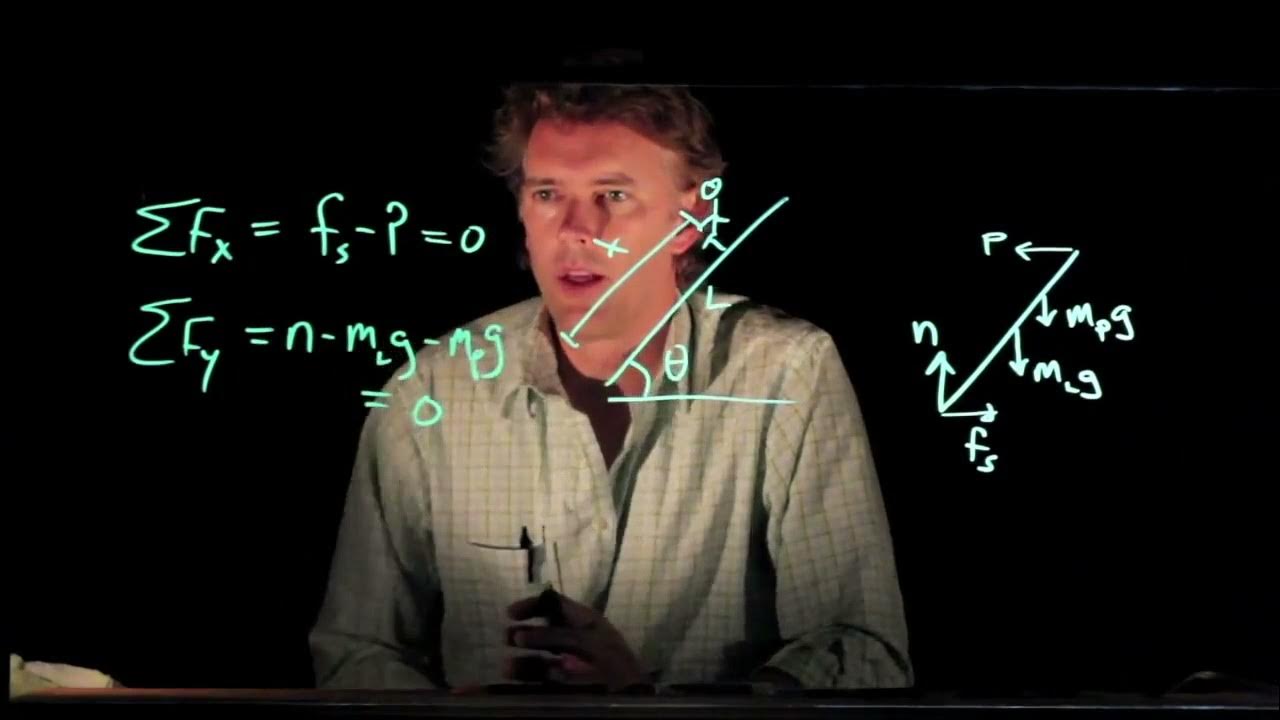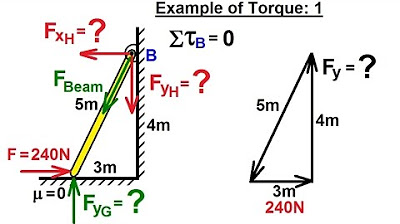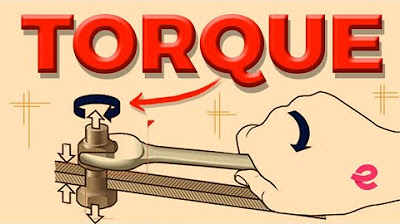Ladder Example for Static Equilibrium
TLDRThe video script discusses a physics problem involving a ladder, a person named Slim Jim, and the concepts of torque and equilibrium. The ladder is 5 meters long, leaning against a wall at a distance of 3 meters, forming a right triangle with the ground and the wall. The force of gravity on the ladder and Slim Jim is calculated, with the ladder's force acting at its center of mass and Slim Jim's force being 600 Newtons due to his weight. The video explains how to use equilibrium conditions to determine the normal force from the wall and the ground, and the frictional force preventing the ladder from sliding. Torque is then introduced as the third condition for equilibrium, with the sum of all torques equaling zero. The moment arm concept is used to calculate the torque caused by each force, and the problem is solved to find the force of the wall and the minimum force of friction needed to keep the ladder in place. The video emphasizes the importance of converting kilograms to Newtons and finding the perpendicular distance (moment arm) for torque calculations.
Takeaways
- 📐 **Understanding Triangles**: The ladder forms a right triangle with the wall, allowing for the calculation of the ladder's distance from the ground using trigonometry.
- 📏 **Calculating Angles**: The angle at the base of the ladder (Theta) is determined to be approximately 53° using the tangent function.
- 🧭 **Static Equilibrium**: The ladder is in static equilibrium, meaning the sum of forces and torques acting on it are zero.
- 🚫 **Converting Units**: It's crucial to convert kilograms to Newtons to avoid errors in the torque equation.
- 🧱 **Center of Mass**: The force of the ladder acts at its center of mass, which is used to calculate the downward force.
- 🔄 **Forces Acting on the Ladder**: The normal force from the wall and frictional force are identified as the other forces acting on the ladder.
- ⚖️ **Equilibrium Conditions**: The forces in the x and y directions must sum to zero to maintain equilibrium.
- 🔩 **Calculating Torque**: Torque is calculated using the formula force times the perpendicular distance from the pivot (moment arm).
- 🔵 **Moment Arm Definition**: The moment arm is the horizontal distance from the pivot to the line of action of the force, not the vertical distance.
- 📊 **Torque Calculation for Slim Jim**: The torque due to Slim Jim's weight is calculated using his force and the moment arm determined by the cosine of the angle.
- 🔴 **Torque Calculation for Ladder's Weight**: The torque due to the ladder's weight is calculated similarly, with attention to the correct moment arm and direction.
- 🟢 **Torque of the Wall's Force**: The wall's force creates a torque in the opposite direction, which is calculated using the sine of the angle.
- 🔎 **Sum of Torques Equals Zero**: The sum of all torques around the pivot must equal zero for equilibrium, leading to the solution for the unknown force.
- 📌 **Frictional Force Calculation**: The minimum force of friction needed to prevent the ladder from slipping is found using the normal force and the calculated torque.
- 🔍 **Coefficient of Friction**: The coefficient of friction (μ) can be determined if the minimum force of friction is known, using μ = force of friction / normal force.
Q & A
What is the length of the ladder mentioned in the transcript?
-The ladder is 5 meters long.
What is the distance of the ladder from the wall?
-The ladder is 3 meters from the wall.
What is the angle Theta in the context of the ladder and the wall?
-Theta is the angle formed between the ladder and the ground, which is found to be approximately 53°.
How is the force of the ladder's weight acting?
-The force of the ladder's weight is acting at its center of mass, which is at the midpoint of the ladder.
What is the force acting on Slim Jim in Newtons if he weighs 60 kilograms?
-The force acting on Slim Jim is 600 Newtons, after converting his weight from kilograms to Newtons.
What are the two forces that need to be balanced for the ladder to be in static equilibrium?
-The two forces that need to be balanced for static equilibrium are the normal force from the wall (FW) and the force of friction.
What is the total force exerted by the ground on the ladder in the vertical direction?
-The total force exerted by the ground on the ladder in the vertical direction is 720 Newtons.
What is the third condition for equilibrium in this context?
-The third condition for equilibrium is the sum of all torques (moments) equals zero.
How is torque calculated in the context of this problem?
-Torque is calculated as the product of the force and the perpendicular distance from the pivot (moment arm).
What is the minimum force of friction needed to keep the ladder in place?
-The minimum force of friction needed to keep the ladder in place is 361 Newtons.
How can you find the coefficient of friction (mu) if you know the normal force and the minimum force of friction?
-You can find the coefficient of friction (mu) by dividing the force of friction by the normal force (mu = force of friction / normal force).
What is the importance of converting kilograms to Newtons when calculating torque?
-Converting kilograms to Newtons is important because the torque equation involves force times distance, and using consistent units (Newtons) ensures accurate calculations.
Outlines
🔍 Static Equilibrium and Ladder Problem Analysis
The video begins with a discussion on a ladder problem involving torque and other concepts studied throughout the year. The ladder, with Slim Jim on it, is positioned 3 meters from a wall, and its length is 5 meters. By applying trigonometric functions, it's determined that the ladder forms a 345 triangle, with the remaining side being 4 meters. The angle between the ladder and the ground is found to be approximately 53 degrees. The forces acting on the ladder are identified, including the force of the ladder itself at its center of mass (120 Newtons), the normal force from the wall (FW), and friction. The video emphasizes the importance of converting kilograms to Newtons to avoid errors in torque calculations. The problem is approached by applying the conditions of static equilibrium in both the X and Y directions, leading to the conclusion that the normal force from the ground must be 720 Newtons. The video then transitions into a discussion on torque, which is the third condition for equilibrium. The right-hand rule is used to determine the direction of torques caused by the forces acting on the ladder. The moment arm concept is introduced to calculate torque, which is the product of the force and the perpendicular distance from the pivot point. The video concludes with a step-by-step process for calculating the torques due to Slim Jim's weight, the ladder's weight, and the wall's force, and solving for the unknown force using the equilibrium condition that the sum of all torques equals zero.
📐 Calculating Torques and Solving for Unknown Force
The second paragraph delves deeper into calculating the torques acting on the ladder system. The force exerted by Slim Jim on the ladder is considered, with a moment arm determined by the horizontal distance from the pivot, which is calculated using the cosine of the known angle (53 degrees). The torque due to Slim Jim's weight (600 Newtons) is found by multiplying the force by the moment arm. Similarly, the torque due to the ladder's weight at its center of mass is calculated, taking into account the perpendicular distance from the pivot point. The video then addresses the torque caused by the wall's force, which acts in the opposite direction and is calculated using the sine of the angle. With all three torques calculated, the video presents the torque equation where the sum of all torques equals zero. By solving this equation, the unknown force exerted by the wall (FW) is determined to be 361 Newtons. This force is identified as the minimum force of friction needed to prevent the ladder from slipping. The video concludes with a reminder to always convert mass to force and to use the appropriate trigonometric relationships when calculating torques.
🔧 Further Exploration of Frictional Force
In the final paragraph, the video script explores the concept of frictional force in more detail. With the normal force calculated as 720 Newtons, the force of friction is discussed in relation to the minimum force required to prevent the ladder from slipping. The coefficient of friction (mu) is introduced as the ratio of the frictional force to the normal force. Although the value of mu is not given, the video demonstrates how it could be calculated if the minimum frictional force (361 Newtons) is known. The video emphasizes the importance of converting units and using the correct formula for torque, which involves either force times distance or distance times force. The moment arm, or the perpendicular distance from the pivot point, is highlighted as a crucial factor in these calculations. The video concludes with a summary of the key points, reminding viewers to be careful with significant figures and to understand the principles of static equilibrium and torque.
Mindmap
Keywords
💡Torque
💡Static Equilibrium
💡Moment Arm
💡Normal Force
💡Friction
💡Center of Mass
💡Cosine
💡Newton's Laws of Motion
💡Right-Angled Triangle
💡Coefficient of Friction (μ)
💡Pivot Point
Highlights
The ladder problem involves torque and other concepts studied throughout the year.
A 5m ladder is positioned 3m from a wall, forming a 3-4-5 triangle to find the remaining side at 4m.
The angle Theta is determined to be approximately 53° using the tangent function.
Static equilibrium is considered, with the ladder's center of mass pulling down with 120 Newtons.
Kilograms are converted to Newtons to avoid confusion in torque equations.
Slim JY's weight of 60 kg is converted to 600 Newtons for force calculations.
The normal force from the wall (FW) is identified to balance the frictional force.
The force of the ground is calculated to be 720 Newtons, balancing the downward forces.
Torque is introduced as the third condition for equilibrium, with the sum of all torques equaling zero.
The right-hand rule is used to determine the direction of torques as positive or negative.
The moment arm concept is explained, focusing on the horizontal distance from the pivot for torque calculations.
The torque of Slim JY and the ladder's center of mass are calculated using the moment arm and respective forces.
The torque of the wall is found by considering the force of the wall and its perpendicular distance from the pivot.
All three torques are summed to set up the equation for equilibrium, solving for the force of the wall (FW).
The minimum force of friction required to prevent the ladder from slipping is calculated to be 361 Newtons.
The coefficient of friction (mu) is determined based on the minimum force of friction and the normal force.
Emphasis is placed on converting units and using the correct method for calculating torque.
The process demonstrates the application of static equilibrium in real-world physics problems.
Transcripts
Browse More Related Video

Torque Example #3: Leaning Ladder Problem

The Leaning Ladder Problem | Physics with Professor Matt Anderson | M12-22

Physics 15 Torque (11 of 27) Example 1: Forces=?

Leaning Ladder Equilibrium Problem: Find Minimum Angle

Physics 15 Torque (21 of 25) More Examples: 3 T=? of Cable of Step Ladder

What is Torque? | Physics | Extraclass.com
5.0 / 5 (0 votes)
Thanks for rating: